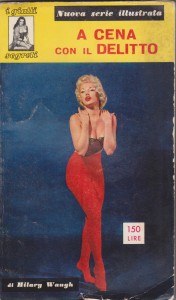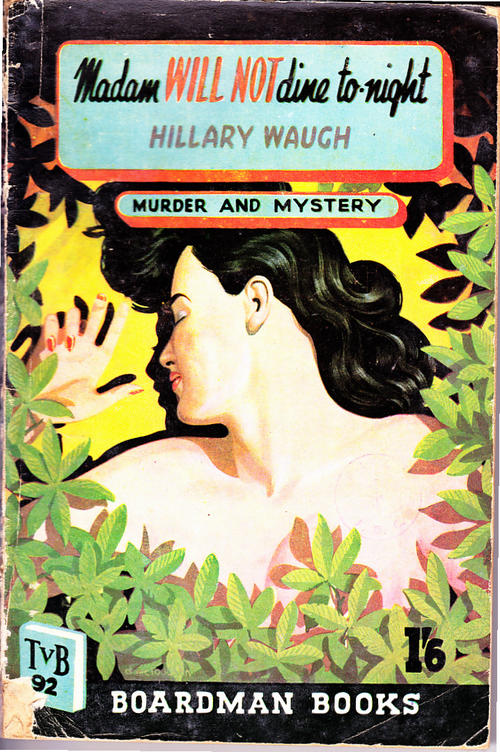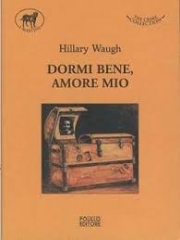About Hillary Waugh I have
already spoken on the occasion of the excellent novel republished by Polillo
Publisher.
Waugh began, however, as I
have already said, with three novels in the classical tradition of Mystery Enigma. It was the first ever written: Madame
Will Not Dine Tonight ,1947.
Sheridan Wesley was invited
to the home of Valerie King for a dinner. Nothing strange if Valerie King was his
acquaintance , but it is not. The invitation is also more strange because to
Sheridan, who is a private investigator, was delivered an envelope with an
invitation, in which was a hundred-dollar bill and also the demand to bring
with him to dinner, an escort: in his case, his wife.
The invitation, which is
already strange in itself, acquires even greater significance when the two arrive
at the home of Valerie and do not find her waiting for them; instead found a
strange company of people: Jimmy Burns, a tabloid journalist; Charley Cromwell,
a playboy; James Godfrey, a lawyer; Gloria Van Ryne, a beautiful girl from a
good family; the Hammitt spouses. The group of individuals gathered there is
all the more strange because they do not know each other- and could even happen
that into a party people do not know - but even more strange is when it is
clear to Wesley and his wife, that some of them say they had never known before
the King: for example spouses Hammitt, Burns and Gloria Van Ryne.
Meanwhile, everyone is waiting
for Valerie, but seems his guests wait
her. Sheridan begins to ask questions: the household, the Webbs, say Valerie
went to town the day before and when
they are returned at ten o'clock in the morning, already she was not in the
house, but she had announced the day before that they would prepare the house
for an evening reception, when they would return. And they had done what
she had ordered. However, this
revelation seems to be in contrast with what Wesley has discovered: Diana's car
is still in the garage. She could not go
to the town from a villa in the countryside without a car! Wesley begins to
smell a rat: if at the house she does not seem to be , somewhere else she will
stand. Around the villa there is a grove: although it is night, it’s cold and
they are dressed in evening gowns, Wesley and Diana walk, illuminating the
ground with a flashlight that he always brings in the car. The fact is that
after theyhave found on a stretch of land, footprints women's heels, and then a
female high-heeled shoe, they find Valerie naked, stabbed and dead , at least since
one day.
They return to the villa and
they call the police.
The surveys are entrusted to
Captain Slocum, who initially distrusts Wesley, thinking abouta red herring,
then he gives him credit for (while distrusting him) when he knows that Wesley
and the Inspector-in-chief Bradley, of the Homicide Squad of the Police New
York, are good friends. As Slocum did stalk Wesley, he instead of supporting the survey, investigates
on his own: first at the opening of the Valerie’s safe , he subtracts from it, a
photo among the documents Slocum gave him, an old photo; then in his absence,
raids deeper the study, where he found,
communicating by phone to the police about the death of Valerie, tobacco
scattered on the carpet and two tins of cigarettes (colored red and green) with
the plugs reversed that he had put in place: pondering about the assumption
that the spouses Webber and in particular the woman claimed to have thoroughly
cleaned the house on Thursday morning before leaving, he concludes that tobacco
had to be dropped after, as during a lite, when the jars were opened and the
cigarettes were finished on the carpet.
By removing the tobacco, he realizes that there are spots on the carpet flattened,
as if for the time it had been leaning over something heavy that he hypothesizes
were the legs of the desk; aligning these to the legs of the desk, he realizes the
areas of the carpet covered temporarily by the legs have spots, presumably of
blood: understanding that is the location where Valerie was killed, he knocks
on the walls to try hypothetical secret drawers and finds instead, behind a
reproduction of a Corot, the bullet of a .38 impacted behind, that he removes
and takes.
After clearing the room, he goes
to deliver the bullet to his friend policeman for ballistics, just to know that
it comes from the gun of a notorious gangster finished long before the electric
chair. Also, doing a search on the newspaper years ago, he dates back to the
people portrayed in the photo he has taken away. They are two robbers, Lenny
Myers and Joe Freeman: the first, that had a younger sister, Virginia Myers,
was executed on electric chair for a murder during a rapine; the second, has
escaped from prison and about it, it has not heard anything; Virginia Myers later
had changed the name in Valerie King. Along with other clues, including cards
and letters kept in the safe, it takes out another portrait of Valerie, not
simple wife, betrayed by a husband who solaced with four lovers, who lives with
the heritage derived from the divorce from her ex-husband, but blackmailer
patented, which blackmailed Cromwell, his former lover, but also probably the
lawyer Godfrey, his lawyer in the divorce proceedings; and probably also the
former husband. It’s possible she also blackmailed the spouses Hammitt? Freeman
at the old photo, older, could be similar to Hammitt? Wesley understand Hammitt
is an escaped convict, who later made
a fortune in the industry. Who will never be the murderer? What’s the value
of the discovery made by Wesley, together with the discovery of blood stains on
the carpet of the study, about a
fragment of a diopter lens?
Madame Will
Not Dine Tonight, which was written while Waugh was still in the
army, was not very successful. Why ? Probably because it did not create
anything new. It would have fascinated unless he repeated some elements of novels
published previously: this is the limit of the novel. It 'an honest product,
very cleverly written, that mixes the Hard Boiled (the stalking, assault in the
night club with fistfight , which hints at many other similar ones, in
particular, contained in Headed for a
Hearse by Jonathan Latimer: the femme fatale, as opposed to his wife, who
wants to get with the sex the fixed result and when she doesn’t get it, she
produces in a waft of obscenities longshoreman) with the deductive Mystery (the
blood on the carpet, which mocks a novel by Ellery Queen, The Egyptian Cross Mystery, the diopter lens route and the exchange
of cigarette boxes, clues linked to color blindness, which makes the verse to
another novel by Ellery Queen, The Greek
Coffin Mystery, and always to this novel by Ellery Queen it may refer Waugh,
with regard to the artistic side of Godfrey, since as in the novel by Queen
there’s the painter's forger Grimshaw, here is the lawyer Godfrey who is also an
accomplished artist; the blackmail, theme already deepened in many other
novels; and also in several previous novels, there is the indication of the
false footprint to sidetrack the
investigation) according to a specified path already own by Jonathan Latimer or
Craig Rice.
Then Waugh adds very personal themes, which are obtained associating once
again, as so often happens in the first few novels by a particular author, the
own personal story to that of his hero. It is no coincidence, for example, the
wife of Wesley, is called Diana, as the wife of Hillary Waugh, and the lawyer
Godfrey dabbles in prints being an accomplished artist, as the same Hillary Waugh
was designer.
A novel, however, we read in one breath, supported by excellent dialogues.
However, the offender can be easily identified on the basis of the projectile
analyzed, a long time ago.
In practice, there is no surprise in the final (we speak of course about
the novel read by avid readers), because the offender can not be that one
person!
Pietro De Palma








